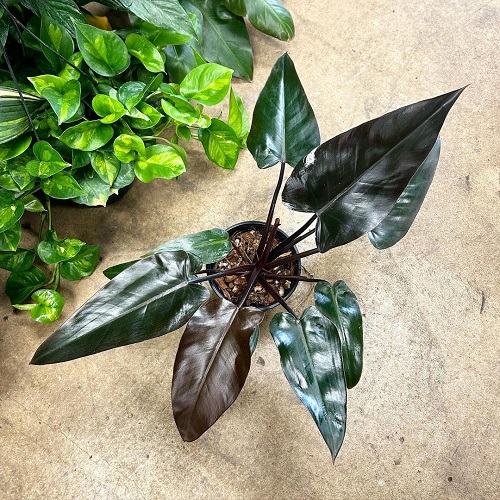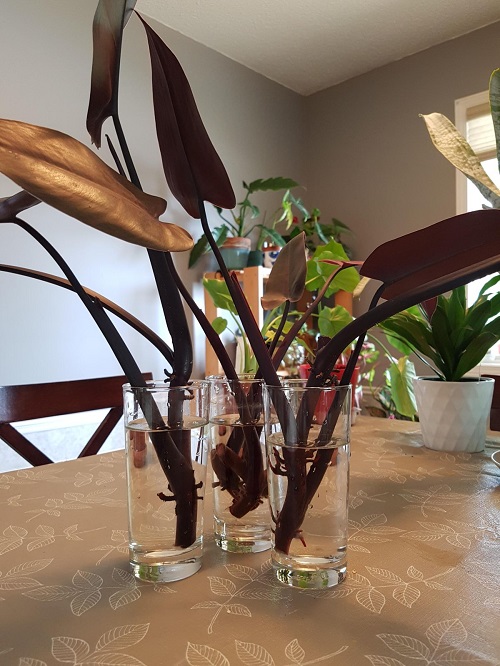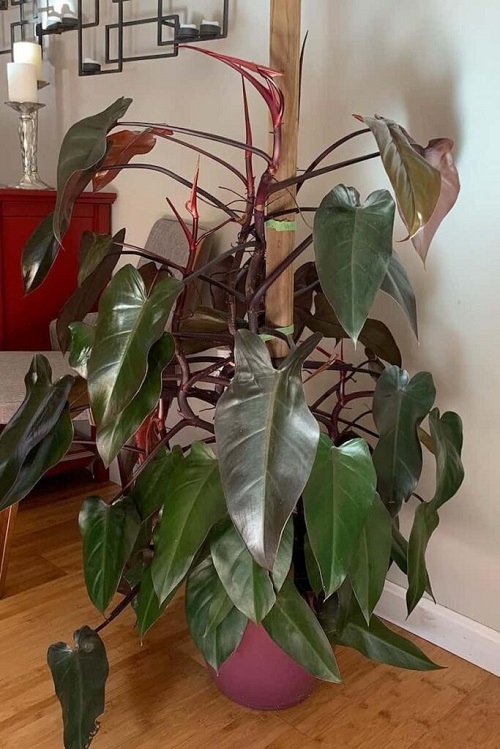Philodendron Bloody Mary lives upto its names with dark as blood leaves! Here’s all you need to know to maintain this spectacular specimen!

Ready to elevate your indoor plant game with a dash of drama? Meet the Philodendron Bloody Mary, a beguiling tropical beauty that boasts not just lush foliage but an arresting color palette unlike any other. Its deep burgundy leaves seem to capture the essence of a breathtaking sunset, making it an instant focal point in any room.
Here is How to Grow and Care for Philodendron Orange Marmalade
Philodendron Bloody Mary Information
Philodendron Bloody Mary belongs to the family of Araceae, which includes many popular houseplants. It is native to the tropical rainforests of South America, specifically Brazil. This plant is cherished for its lush green foliage and unique characteristics.
The plant features heart-shaped leaves that have a striking dark red or burgundy color, hence the name “Bloody Mary.” The leaves are glossy and grow on long, trailing vines, adding a touch of elegance to any indoor space. Its compact and bushy growth habit makes it a perfect choice for tabletops or hanging baskets.
What makes the Philodendron Bloody Mary truly special is its ability to change colors depending on light conditions. When exposed to brighter light, the foliage intensifies in its red hue. However, under lower light conditions, it may display a deeper green shade. This color-changing characteristic adds an element of intrigue and visual interest to the plant, making it a captivating choice for plant enthusiasts and collectors alike.
Here is our Philodendron Brandi Care and Growing Guide
Propagating Philodendron Bloody Mary from Cuttings
Here is how you can easily propagate Bloody Mary Philodendron from plant cuttings:
- Start by selecting a healthy Philodendron Bloody Mary plant and identifying a suitable stem for propagation.
- Using a clean and sharp pair of pruning shears, make a clean cut just below a node on the selected stem.
- Remove any lower leaves from the stem, leaving only a few leaves at the top. This helps redirect the plant’s energy toward root development rather than supporting excessive foliage.
- Fill a small container with a well-draining propagation medium. Ensure the container has drainage holes to prevent waterlogging.
- Moisten the propagation medium lightly, ensuring it is damp but not soggy. Dip the cut end of the stem into a rooting hormone powder to encourage root growth.
- Create a small hole in the propagation medium and gently insert the lower end of the stem into the hole. Firmly press the medium around the stem to provide stability.
- Place the container in a warm and humid location with bright, indirect light. Avoid placing it in direct sunlight, as it may lead to leaf burn.
Propagate Any Plant Cutting Quickly Using this Trick
Best Pot Size for Philodendron Bloody Mary
The ideal pot size for growing a Philodendron Bloody Mary at home depends on the current size of the plant and its growth. A pot with a diameter of 6 to 8 inches is suitable for young plants. This allows for adequate root space and promotes healthy growth.
As the plant matures and its root system expands, you should transplant it into a pot that’s one size bigger than the old one.
Here are Plant Pot Sizes from Inches to Gallon
Requirements for Growing Philodendron Bloody Mary
Sunlight
Philodendron Bloody Mary thrives in bright, indirect sunlight. Place it in a location where it receives filtered or indirect sunlight throughout the day, such as near a window covered with a sheer curtain.
Avoid exposing it to direct sunlight, as it can scorch the leaves.
Soil
The plant prefers a well-draining potting mix. A combination of peat moss, perlite, and regular potting soil works well. It’s important to ensure that the soil is moist but not soggy, allowing excess water to drain away.
Here are the best recipes to make the perfect growing medium for your plants
Water
Watering the plant regularly is essential to keep it healthy. Philodendron Bloody Mary appreciates slightly moist soil, but be careful not to overwater. Wait until the top inch of the soil feels dry before watering again.
Here are the best ways to water plants
It’s always better to underwater than to overwater, as excessive moisture can lead to root rot.
Temperature and Humidity
Philodendron Bloody Mary prefers temperatures between 65°F and 80°F (18°C to 27°C). It can tolerate slightly lower temperatures but should be protected from cold drafts.
As for humidity, it appreciates moderate to high humidity levels. You can increase humidity by placing a tray of water near the plant or using a humidifier.
Check out these 10 Ways To Increase Humidity For Houseplants That Work
Philodendron Bloody Mary Care
Fertilizer
Fertilizing your Bloody Mary Philodendron can help promote healthy growth. During the growing season, which typically spans spring and summer, you can use a balanced liquid fertilizer diluted to half strength.
Here are the Best DIY Potassium Fertilizer Recipes
Apply the fertilizer once every 4-6 weeks. However, during the dormant period in fall and winter, it’s best to withhold fertilization as the plant’s growth slows down.
Pruning
Pruning is not usually required for Philodendron Bloody Mary, but you can trim away any dead or yellowing leaves to maintain its appearance. If the plant becomes leggy or overgrown, you can trim back the stems to encourage bushier growth.
Use clean, sharp pruning shears to make clean cuts and avoid any unnecessary damage to the plant.
Pests and Diseases
Philodendron Bloody Mary can be susceptible to common houseplant pests such as spider mites, mealybugs, and aphids. Regularly inspect the plant for any signs of infestation, such as webbing, sticky residue, or visible insects. If pests are detected, treat the plant with an appropriate insecticidal soap or neem oil spray, following the instructions on the product label.
Click here to learn the Amazing Natural Pesticide Recipe that can Kill any Pest
Diseases are not typically a major concern for this Philodendron, but overwatering or poor drainage can lead to root rot. To prevent this, ensure the soil is well-draining and avoid overwatering the plant. If root rot is suspected, it’s essential to address the issue promptly by adjusting the watering routine and, if necessary, repotting the plant in fresh, well-draining soil.





